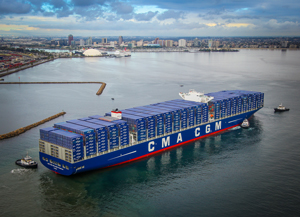When American Export Lines finally received a long-awaited email on March 31 from a shipping line detailing its April schedule, it came too late to do the company much good.
“I can’t really do anything with this,” Kasra Ferasat, marketing director of the Willowbrook-based freight forwarder, fumed last week. “Our customers expect us to have information a month before a shipment for proper planning, not a day before.”
This is exactly what freight-forwarding and trucking companies such as American Export Lines were wary of as three global shipping alliances made their debut April 1. The alliances include major carriers that call at the ports of Long Beach and Los Angeles, the nation’s largest shipping complex.
The alliances, which came as a reaction to shipping industry struggles in recent years, allow carriers to share space on vessels as a way to address overcapacity and cut costs.
But other links in the supply chain have been bracing for chaos with the latest rollout. Everyone from freight forwarders, cargo owners, terminal operators, truckers, and chassis companies are expected to be affected.
“Having these alliances optimizes space and costs for liners, but it does not consider the downstream effect on the supply chain, which is now in tremendous chaos,” said Nick Vyas, executive director at the Center for Global Supply Chain Management at USC.
Teaming up
In the mid-2000s, shipping lines thought the future of the industry was in larger carriers, so they built megaships such as the CMA CGM Abraham Lincoln, a 20-story-tall vessel longer than the Empire State Building is high that was the largest ship to ever call at the ports of Los Angeles and Long Beach.
But while ships grew, trade didn’t. The recession and the sheer size of megaships created a glut of cargo space that couldn’t be filled and in turn drove down prices. In response, carriers formed alliances to share space on vessels.
Vyas said this can have a domino effect.
“For example, let’s say (Mediterranean Shipping Co.) worked with Toys R Us prior to the alliances,” he said. “The liner would pick up the goods at the port of Shanghai, for example, and deliver to Port of Los Angeles at a terminal.”
The terminal operators would know exactly what cargo is on that ship and for whom it is being delivered.
“Now with the alliances, MSC isn’t just carrying its goods, it’s carrying cargo from liners in its alliance,” Vyas said. “So, not only do we have the possibility of cargo mix-up, but stakeholders (truckers, freight-forwarding companies, et al.) may not be informed in a timely manner what ship its freight is on.”
With 40 percent of U.S. container imports coming through the ports of Los Angeles and Long Beach, such delays in receiving and delivering cargo are likely to impact businesses across the country. The two ports together handle more than 15 million cargo containers and tens of thousands of automobiles annually, accounting for 265 metric tons of goods valued at about $450 billion.
The three alliances are 2M, a partnership of the world’s two largest carriers, Denmark’s Maersk Line and Geneva-based Mediterranean Shipping; Ocean Alliance, made up of four carriers, including French and Chinese lines; and one known as the Alliance, with five members including three Japanese carriers.
They will account for 96 percent of container capacity trade among Asia and West Coast ports and 77 percent of global container capacity, according to the Port of Long Beach.
‘Wave of confusion’
Port officials have acknowledged the challenges and said they are doing what they can to help smooth the transition.
Gene Seroka, executive director of the Port of Los Angeles, told stakeholders in December to expect “another wave of confusion” as carriers and terminal operators get used to the new alliances.
One ongoing issue that might only be aggravated by the alliances is a shortage of chassis, the trailers that attach to the back of trucks to hold cargo containers.
The ports said they will address the problem, but how exactly they plan to do that isn’t clear.
“Basically, in peak season you can’t find a chassis, and in off season there are too many on terminal grounds,” Robert Krieger, president of Carson freight forwarder Norman Krieger Inc., said in an email.
In anticipation of the alliances, the Port of Long Beach said in a statement it had been closely monitoring the situation for the last three months by engaging with leadership and operations staff of shipping lines, terminal operators, labor groups, truckers, and railroads.
But American Export Lines’ Ferasat said his biggest frustration has been a lack of communication, particularly from the cargo carriers.
It takes a few weeks to write up contracts and map a customer’s route, which includes booking shipping rates, knowing what carrier will be carrying goods, filling out customs paperwork, and lining up trucks for cargo pickup, he said.
Receiving an email from a liner about its monthly schedule a day before the timetable goes into effect rules that company out as an option when planning a complicated logistics process for freight movement.
“The services are quite a mess with carriers now specifically because of the alliances,” Ferasat said. “It’s going to be a long next few months.”

